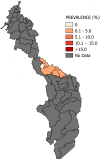Prevalence of Chagas disease in Colombia: A systematic review and meta-analysis
- PMID: 30615644
- PMCID: PMC6322748
- DOI: 10.1371/journal.pone.0210156
Prevalence of Chagas disease in Colombia: A systematic review and meta-analysis
Abstract
Background: Despite the adoption of campaigns to interrupt the main vector and to detect Trypanosoma cruzi in blood banks, millions of people are still chronically infected; however, the prevalence data are limited, and the epidemiology of Chagas disease has not been systematically evaluated. This study aimed to estimate the prevalence of Chagas disease in Colombia.
Methods: A systematic literature review and meta-analysis was conducted to select all observational studies reporting the prevalence of Chagas disease in Colombia, based on serological diagnosis in participants of any age and published between January 2007 and November 2017. Pooled estimates and 95% confidence intervals (95% CIs) were calculated using random-effects models. In addition, the I2 statistic was calculated.
Results: The literature search yielded a total of 1,510 studies; sixteen articles with relevant prevalence data were included in the systematic review. Of these, only 12 articles were included for entry in the meta-analysis. The pooled prevalence of Chagas disease across studies was 2.0% (95% CI: 1.0-4.0). A high degree of heterogeneity was found among studies (I2 > 75%; p < 0.001). The publication bias was not statistically significant (Egger's test, p = 0.078). The highest pooled prevalences were found in the adult population (3.0%, 95% CI: 1.0-4.0), pregnant women (3.0%, 95% CI: 3.0-4.0) and the Orinoco region (7.0%, 95% CI: 2.2-12.6).
Conclusions: The results indicate that the T. cruzi-infected population is aging, the adult population, pregnant women and that the Orinoco region (department of Casanare) have the highest prevalences. These results highlight the need to maintain screening and surveillance programs to identify people with chronic T. cruzi infections.
Conflict of interest statement
The authors have declared that no competing interests exist.
Figures










References
-
- World Health Organization. Chagas disease in Latin America: an epidemiological update based on 2010 estimates Wkly Epidemiol Rec. 2015; 33–44. - PubMed
-
- Guhl F, Aguilera G, Pinto N, Vergara D. [Updated geographical distribution and ecoepidemiology of the triatomine fauna (Reduviidae: Triatominae) in Colombia]. Biomedica. Colombia; 2007;27 Suppl 1: 143–162. - PubMed
Publication types
MeSH terms
LinkOut - more resources
Full Text Sources
Medical

